towing FIAT PANDA 2015 319 / 3.G Owners Manual
[x] Cancel search | Manufacturer: FIAT, Model Year: 2015, Model line: PANDA, Model: FIAT PANDA 2015 319 / 3.GPages: 196, PDF Size: 19.49 MB
Page 36 of 196
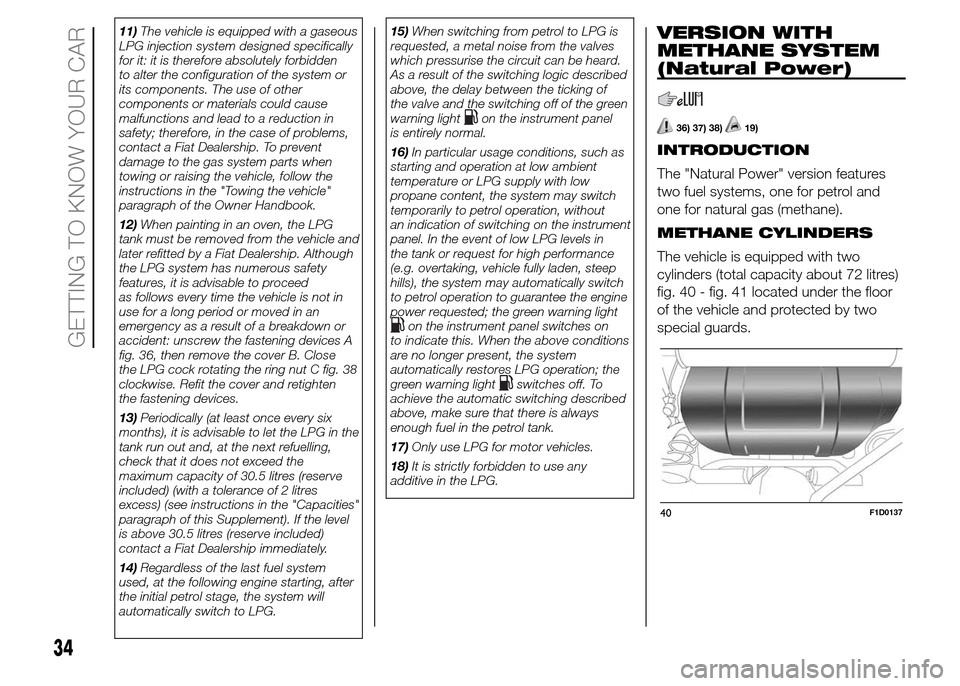
11)The vehicle is equipped with a gaseous
LPG injection system designed specifically
for it: it is therefore absolutely forbidden
to alter the configuration of the system or
its components. The use of other
components or materials could cause
malfunctions and lead to a reduction in
safety; therefore, in the case of problems,
contact a Fiat Dealership. To prevent
damage to the gas system parts when
towing or raising the vehicle, follow the
instructions in the "Towing the vehicle"
paragraph of the Owner Handbook.
12)When painting in an oven, the LPG
tank must be removed from the vehicle and
later refitted by a Fiat Dealership. Although
the LPG system has numerous safety
features, it is advisable to proceed
as follows every time the vehicle is not in
use for a long period or moved in an
emergency as a result of a breakdown or
accident: unscrew the fastening devices A
fig. 36, then remove the cover B. Close
the LPG cock rotating the ring nut C fig. 38
clockwise. Refit the cover and retighten
the fastening devices.
13)Periodically (at least once every six
months), it is advisable to let the LPG in the
tank run out and, at the next refuelling,
check that it does not exceed the
maximum capacity of 30.5 litres (reserve
included) (with a tolerance of 2 litres
excess) (see instructions in the "Capacities"
paragraph of this Supplement). If the level
is above 30.5 litres (reserve included)
contact a Fiat Dealership immediately.
14)Regardless of the last fuel system
used, at the following engine starting, after
the initial petrol stage, the system will
automatically switch to LPG.15)When switching from petrol to LPG is
requested, a metal noise from the valves
which pressurise the circuit can be heard.
As a result of the switching logic described
above, the delay between the ticking of
the valve and the switching off of the green
warning light
on the instrument panel
is entirely normal.
16)In particular usage conditions, such as
starting and operation at low ambient
temperature or LPG supply with low
propane content, the system may switch
temporarily to petrol operation, without
an indication of switching on the instrument
panel. In the event of low LPG levels in
the tank or request for high performance
(e.g. overtaking, vehicle fully laden, steep
hills), the system may automatically switch
to petrol operation to guarantee the engine
power requested; the green warning light
on the instrument panel switches on
to indicate this. When the above conditions
are no longer present, the system
automatically restores LPG operation; the
green warning light
switches off. To
achieve the automatic switching described
above, make sure that there is always
enough fuel in the petrol tank.
17)Only use LPG for motor vehicles.
18)It is strictly forbidden to use any
additive in the LPG.
VERSION WITH
METHANE SYSTEM
(Natural Power)
36) 37) 38)19)
INTRODUCTION
The "Natural Power" version features
two fuel systems, one for petrol and
one for natural gas (methane).
METHANE CYLINDERS
The vehicle is equipped with two
cylinders (total capacity about 72 litres)
fig. 40 - fig. 41 located under the floor
of the vehicle and protected by two
special guards.
40F1D0137
34
GETTING TO KNOW YOUR CAR
Page 38 of 196
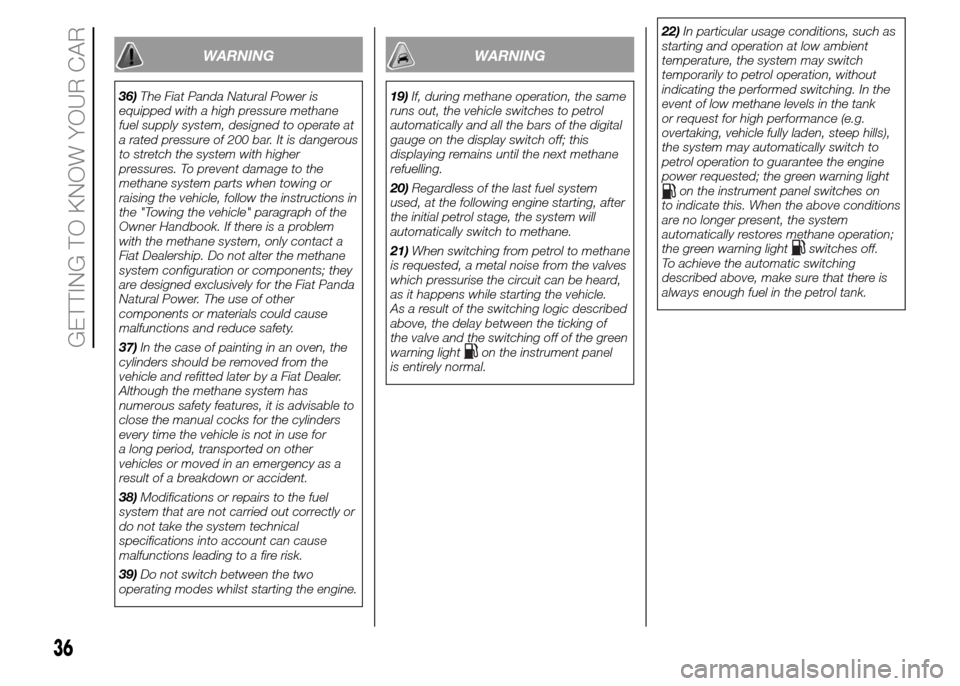
WARNING
36)The Fiat Panda Natural Power is
equipped with a high pressure methane
fuel supply system, designed to operate at
a rated pressure of 200 bar. It is dangerous
to stretch the system with higher
pressures. To prevent damage to the
methane system parts when towing or
raising the vehicle, follow the instructions in
the "Towing the vehicle" paragraph of the
Owner Handbook. If there is a problem
with the methane system, only contact a
Fiat Dealership. Do not alter the methane
system configuration or components; they
are designed exclusively for the Fiat Panda
Natural Power. The use of other
components or materials could cause
malfunctions and reduce safety.
37)In the case of painting in an oven, the
cylinders should be removed from the
vehicle and refitted later by a Fiat Dealer.
Although the methane system has
numerous safety features, it is advisable to
close the manual cocks for the cylinders
every time the vehicle is not in use for
a long period, transported on other
vehicles or moved in an emergency as a
result of a breakdown or accident.
38)Modifications or repairs to the fuel
system that are not carried out correctly or
do not take the system technical
specifications into account can cause
malfunctions leading to a fire risk.
39)Do not switch between the two
operating modes whilst starting the engine.
WARNING
19)If, during methane operation, the same
runs out, the vehicle switches to petrol
automatically and all the bars of the digital
gauge on the display switch off; this
displaying remains until the next methane
refuelling.
20)Regardless of the last fuel system
used, at the following engine starting, after
the initial petrol stage, the system will
automatically switch to methane.
21)When switching from petrol to methane
is requested, a metal noise from the valves
which pressurise the circuit can be heard,
as it happens while starting the vehicle.
As a result of the switching logic described
above, the delay between the ticking of
the valve and the switching off of the green
warning light
on the instrument panel
is entirely normal.22)In particular usage conditions, such as
starting and operation at low ambient
temperature, the system may switch
temporarily to petrol operation, without
indicating the performed switching. In the
event of low methane levels in the tank
or request for high performance (e.g.
overtaking, vehicle fully laden, steep hills),
the system may automatically switch to
petrol operation to guarantee the engine
power requested; the green warning light
on the instrument panel switches on
to indicate this. When the above conditions
are no longer present, the system
automatically restores methane operation;
the green warning light
switches off.
To achieve the automatic switching
described above, make sure that there is
always enough fuel in the petrol tank.
36
GETTING TO KNOW YOUR CAR
Page 48 of 196
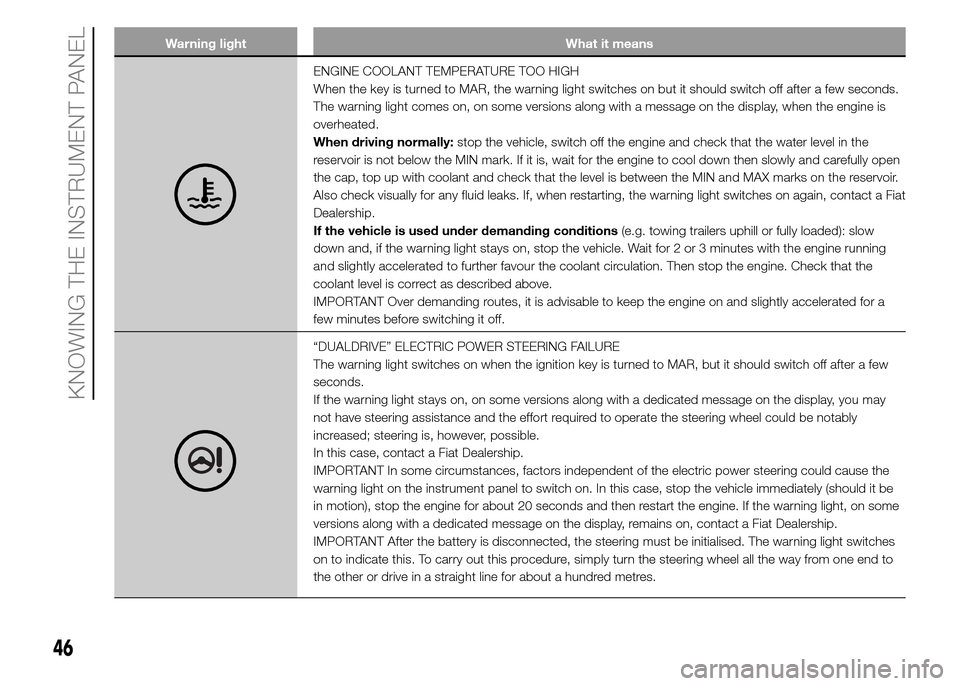
Warning light What it means
ENGINE COOLANT TEMPERATURE TOO HIGH
When the key is turned to MAR, the warning light switches on but it should switch off after a few seconds.
The warning light comes on, on some versions along with a message on the display, when the engine is
overheated.
When driving normally:stop the vehicle, switch off the engine and check that the water level in the
reservoir is not below the MIN mark. If it is, wait for the engine to cool down then slowly and carefully open
the cap, top up with coolant and check that the level is between the MIN and MAX marks on the reservoir.
Also check visually for any fluid leaks. If, when restarting, the warning light switches on again, contact a Fiat
Dealership.
If the vehicle is used under demanding conditions(e.g. towing trailers uphill or fully loaded): slow
down and, if the warning light stays on, stop the vehicle. Wait for 2 or 3 minutes with the engine running
and slightly accelerated to further favour the coolant circulation. Then stop the engine. Check that the
coolant level is correct as described above.
IMPORTANT Over demanding routes, it is advisable to keep the engine on and slightly accelerated for a
few minutes before switching it off.
“DUALDRIVE” ELECTRIC POWER STEERING FAILURE
The warning light switches on when the ignition key is turned to MAR, but it should switch off after a few
seconds.
If the warning light stays on, on some versions along with a dedicated message on the display, you may
not have steering assistance and the effort required to operate the steering wheel could be notably
increased; steering is, however, possible.
In this case, contact a Fiat Dealership.
IMPORTANT In some circumstances, factors independent of the electric power steering could cause the
warning light on the instrument panel to switch on. In this case, stop the vehicle immediately (should it be
in motion), stop the engine for about 20 seconds and then restart the engine. If the warning light, on some
versions along with a dedicated message on the display, remains on, contact a Fiat Dealership.
IMPORTANT After the battery is disconnected, the steering must be initialised. The warning light switches
on to indicate this. To carry out this procedure, simply turn the steering wheel all the way from one end to
the other or drive in a straight line for about a hundred metres.
46
KNOWING THE INSTRUMENT PANEL
Page 71 of 196
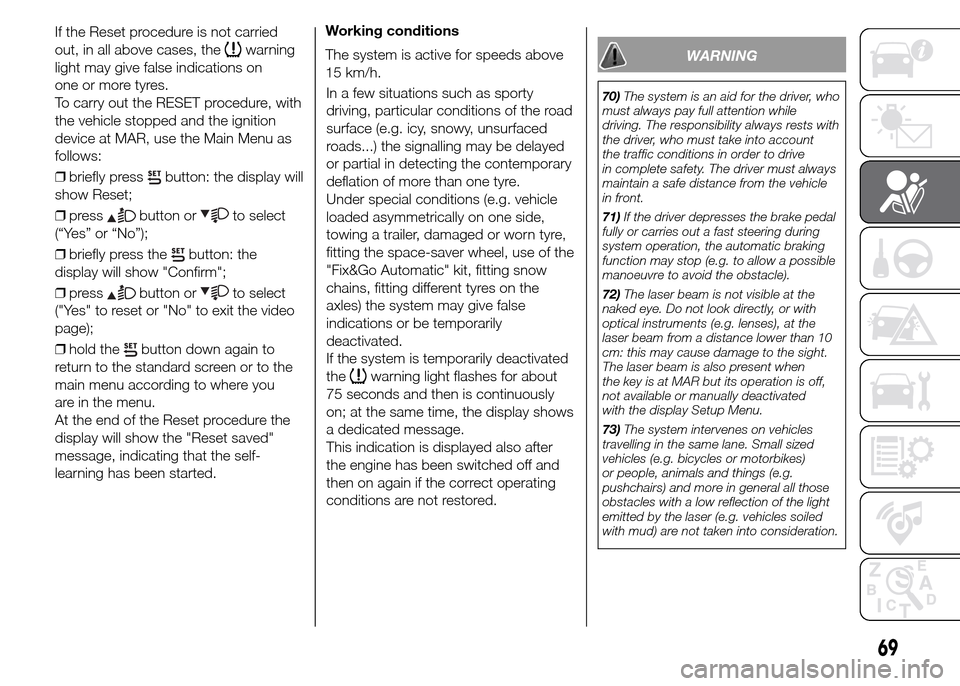
If the Reset procedure is not carried
out, in all above cases, the
warning
light may give false indications on
one or more tyres.
To carry out the RESET procedure, with
the vehicle stopped and the ignition
device at MAR, use the Main Menu as
follows:
❒briefly press
button: the display will
show Reset;
❒press
button orto select
(“Yes” or “No”);
❒briefly press the
button: the
display will show "Confirm";
❒press
button orto select
("Yes" to reset or "No" to exit the video
page);
❒hold the
button down again to
return to the standard screen or to the
main menu according to where you
are in the menu.
At the end of the Reset procedure the
display will show the "Reset saved"
message, indicating that the self-
learning has been started.Working conditions
The system is active for speeds above
15 km/h.
In a few situations such as sporty
driving, particular conditions of the road
surface (e.g. icy, snowy, unsurfaced
roads...) the signalling may be delayed
or partial in detecting the contemporary
deflation of more than one tyre.
Under special conditions (e.g. vehicle
loaded asymmetrically on one side,
towing a trailer, damaged or worn tyre,
fitting the space-saver wheel, use of the
"Fix&Go Automatic" kit, fitting snow
chains, fitting different tyres on the
axles) the system may give false
indications or be temporarily
deactivated.
If the system is temporarily deactivated
the
warning light flashes for about
75 seconds and then is continuously
on; at the same time, the display shows
a dedicated message.
This indication is displayed also after
the engine has been switched off and
then on again if the correct operating
conditions are not restored.
WARNING
70)The system is an aid for the driver, who
must always pay full attention while
driving. The responsibility always rests with
the driver, who must take into account
the traffic conditions in order to drive
in complete safety. The driver must always
maintain a safe distance from the vehicle
in front.
71)If the driver depresses the brake pedal
fully or carries out a fast steering during
system operation, the automatic braking
function may stop (e.g. to allow a possible
manoeuvre to avoid the obstacle).
72)The laser beam is not visible at the
naked eye. Do not look directly, or with
optical instruments (e.g. lenses), at the
laser beam from a distance lower than 10
cm: this may cause damage to the sight.
The laser beam is also present when
the key is at MAR but its operation is off,
not available or manually deactivated
with the display Setup Menu.
73)The system intervenes on vehicles
travelling in the same lane. Small sized
vehicles (e.g. bicycles or motorbikes)
or people, animals and things (e.g.
pushchairs) and more in general all those
obstacles with a low reflection of the light
emitted by the laser (e.g. vehicles soiled
with mud) are not taken into consideration.
69
Page 90 of 196
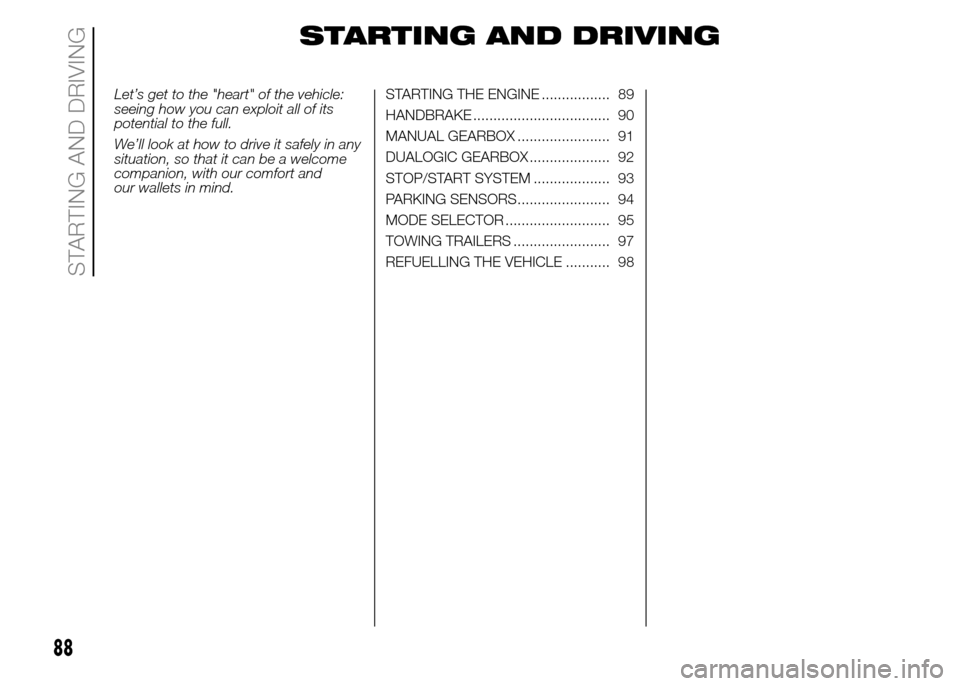
STARTING AND DRIVING
Let’s get to the "heart" of the vehicle:
seeing how you can exploit all of its
potential to the full.
We’ll look at how to drive it safely in any
situation, so that it can be a welcome
companion, with our comfort and
our wallets in mind.STARTING THE ENGINE ................. 89
HANDBRAKE .................................. 90
MANUAL GEARBOX ....................... 91
DUALOGIC GEARBOX .................... 92
STOP/START SYSTEM ................... 93
PARKING SENSORS....................... 94
MODE SELECTOR .......................... 95
TOWING TRAILERS ........................ 97
REFUELLING THE VEHICLE ........... 98
88
STARTING AND DRIVING
Page 92 of 196
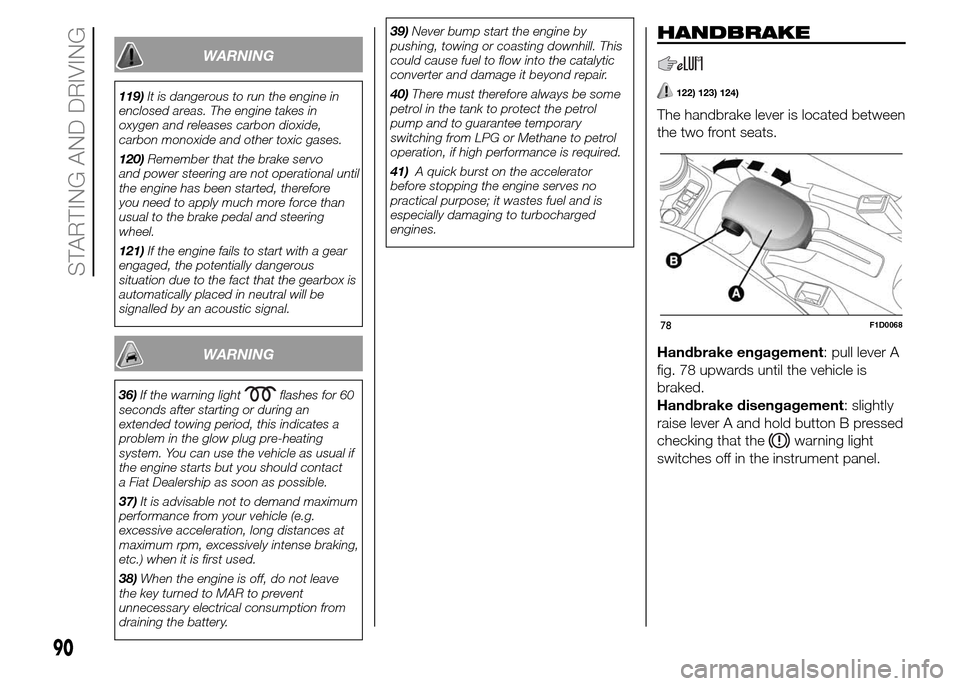
WARNING
119)It is dangerous to run the engine in
enclosed areas. The engine takes in
oxygen and releases carbon dioxide,
carbon monoxide and other toxic gases.
120)Remember that the brake servo
and power steering are not operational until
the engine has been started, therefore
you need to apply much more force than
usual to the brake pedal and steering
wheel.
121)If the engine fails to start with a gear
engaged, the potentially dangerous
situation due to the fact that the gearbox is
automatically placed in neutral will be
signalled by an acoustic signal.
WARNING
36)If the warning lightflashes for 60
seconds after starting or during an
extended towing period, this indicates a
problem in the glow plug preheating
system. You can use the vehicle as usual if
the engine starts but you should contact
a Fiat Dealership as soon as possible.
37)It is advisable not to demand maximum
performance from your vehicle (e.g.
excessive acceleration, long distances at
maximum rpm, excessively intense braking,
etc.) when it is first used.
38)When the engine is off, do not leave
the key turned to MAR to prevent
unnecessary electrical consumption from
draining the battery.39)Never bump start the engine by
pushing, towing or coasting downhill. This
could cause fuel to flow into the catalytic
converter and damage it beyond repair.
40)There must therefore always be some
petrol in the tank to protect the petrol
pump and to guarantee temporary
switching from LPG or Methane to petrol
operation, if high performance is required.
41)A quick burst on the accelerator
before stopping the engine serves no
practical purpose; it wastes fuel and is
especially damaging to turbocharged
engines.
HANDBRAKE
122) 123) 124)
The handbrake lever is located between
the two front seats.
Handbrake engagement: pull lever A
fig. 78 upwards until the vehicle is
braked.
Handbrake disengagement: slightly
raise lever A and hold button B pressed
checking that the
warning light
switches off in the instrument panel.
78F1D0068
90
STARTING AND DRIVING
Page 99 of 196
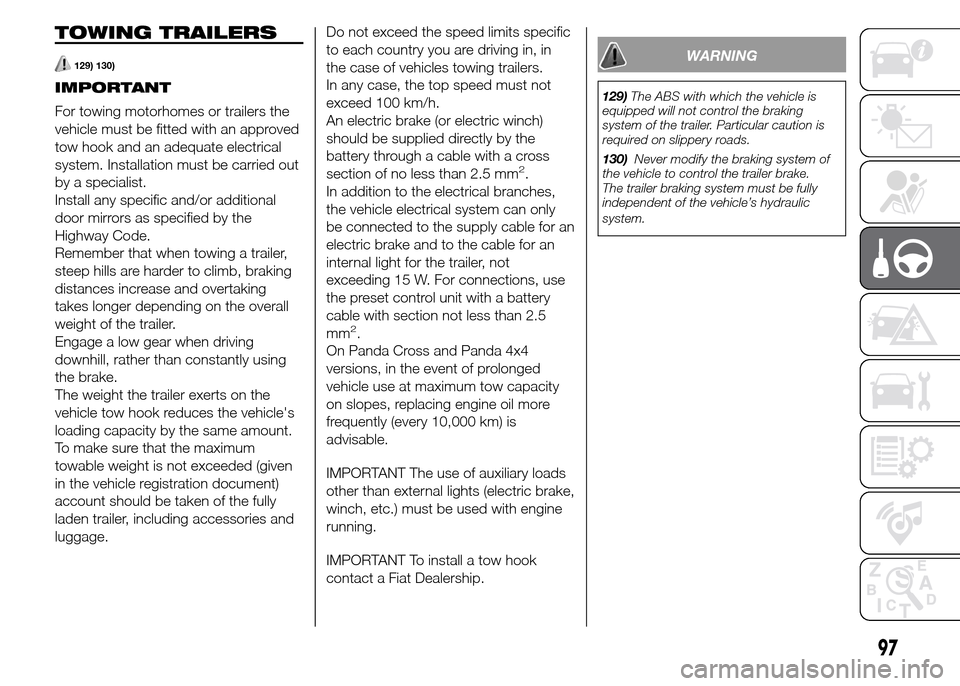
TOWING TRAILERS
129) 130)
IMPORTANT
For towing motorhomes or trailers the
vehicle must be fitted with an approved
tow hook and an adequate electrical
system. Installation must be carried out
by a specialist.
Install any specific and/or additional
door mirrors as specified by the
Highway Code.
Remember that when towing a trailer,
steep hills are harder to climb, braking
distances increase and overtaking
takes longer depending on the overall
weight of the trailer.
Engage a low gear when driving
downhill, rather than constantly using
the brake.
The weight the trailer exerts on the
vehicle tow hook reduces the vehicle's
loading capacity by the same amount.
To make sure that the maximum
towable weight is not exceeded (given
in the vehicle registration document)
account should be taken of the fully
laden trailer, including accessories and
luggage.Do not exceed the speed limits specific
to each country you are driving in, in
the case of vehicles towing trailers.
In any case, the top speed must not
exceed 100 km/h.
An electric brake (or electric winch)
should be supplied directly by the
battery through a cable with a cross
section of no less than 2.5 mm
2.
In addition to the electrical branches,
the vehicle electrical system can only
be connected to the supply cable for an
electric brake and to the cable for an
internal light for the trailer, not
exceeding 15 W. For connections, use
the preset control unit with a battery
cable with section not less than 2.5
mm
2.
On Panda Cross and Panda 4x4
versions, in the event of prolonged
vehicle use at maximum tow capacity
on slopes, replacing engine oil more
frequently (every 10,000 km) is
advisable.
IMPORTANT The use of auxiliary loads
other than external lights (electric brake,
winch, etc.) must be used with engine
running.
IMPORTANT To install a tow hook
contact a Fiat Dealership.
WARNING
129)The ABS with which the vehicle is
equipped will not control the braking
system of the trailer. Particular caution is
required on slippery roads.
130)Never modify the braking system of
the vehicle to control the trailer brake.
The trailer braking system must be fully
independent of the vehicle’s hydraulic
system.
97
Page 103 of 196
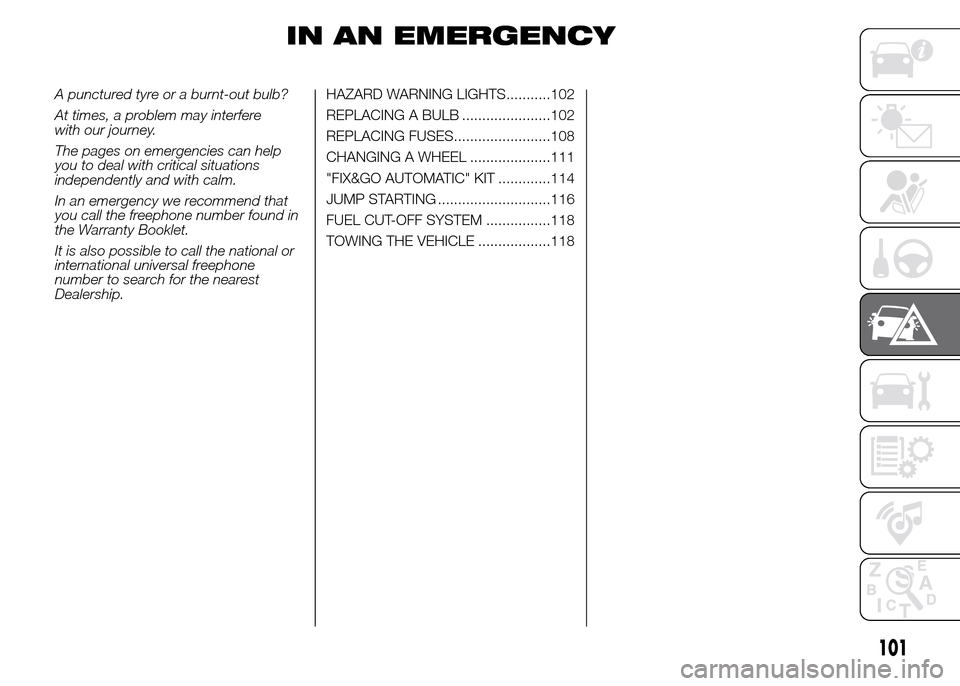
IN AN EMERGENCY
A punctured tyre or a burnt-out bulb?
At times, a problem may interfere
with our journey.
The pages on emergencies can help
you to deal with critical situations
independently and with calm.
In an emergency we recommend that
you call the freephone number found in
the Warranty Booklet.
It is also possible to call the national or
international universal freephone
number to search for the nearest
Dealership.HAZARD WARNING LIGHTS...........102
REPLACING A BULB ......................102
REPLACING FUSES........................108
CHANGING A WHEEL ....................111
"FIX&GO AUTOMATIC" KIT .............114
JUMP STARTING ............................116
FUEL CUT-OFF SYSTEM ................118
TOWING THE VEHICLE ..................118
101
Page 120 of 196
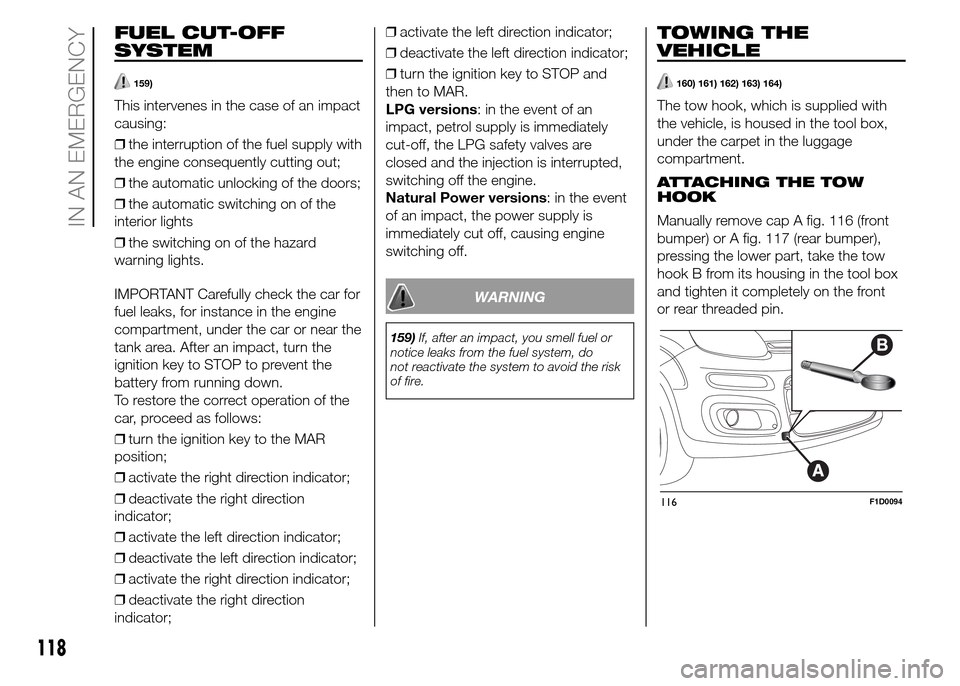
FUEL CUT-OFF
SYSTEM
159)
This intervenes in the case of an impact
causing:
❒the interruption of the fuel supply with
the engine consequently cutting out;
❒the automatic unlocking of the doors;
❒the automatic switching on of the
interior lights
❒the switching on of the hazard
warning lights.
IMPORTANT Carefully check the car for
fuel leaks, for instance in the engine
compartment, under the car or near the
tank area. After an impact, turn the
ignition key to STOP to prevent the
battery from running down.
To restore the correct operation of the
car, proceed as follows:
❒turn the ignition key to the MAR
position;
❒activate the right direction indicator;
❒deactivate the right direction
indicator;
❒activate the left direction indicator;
❒deactivate the left direction indicator;
❒activate the right direction indicator;
❒deactivate the right direction
indicator;❒activate the left direction indicator;
❒deactivate the left direction indicator;
❒turn the ignition key to STOP and
then to MAR.
LPG versions: in the event of an
impact, petrol supply is immediately
cut-off, the LPG safety valves are
closed and the injection is interrupted,
switching off the engine.
Natural Power versions: in the event
of an impact, the power supply is
immediately cut off, causing engine
switching off.
WARNING
159)If, after an impact, you smell fuel or
notice leaks from the fuel system, do
not reactivate the system to avoid the risk
of fire.
TOWING THE
VEHICLE
160) 161) 162) 163) 164)
The tow hook, which is supplied with
the vehicle, is housed in the tool box,
under the carpet in the luggage
compartment.
ATTACHING THE TOW
HOOK
Manually remove cap A fig. 116 (front
bumper) or A fig. 117 (rear bumper),
pressing the lower part, take the tow
hook B from its housing in the tool box
and tighten it completely on the front
or rear threaded pin.
116F1D0094
118
IN AN EMERGENCY
Page 121 of 196
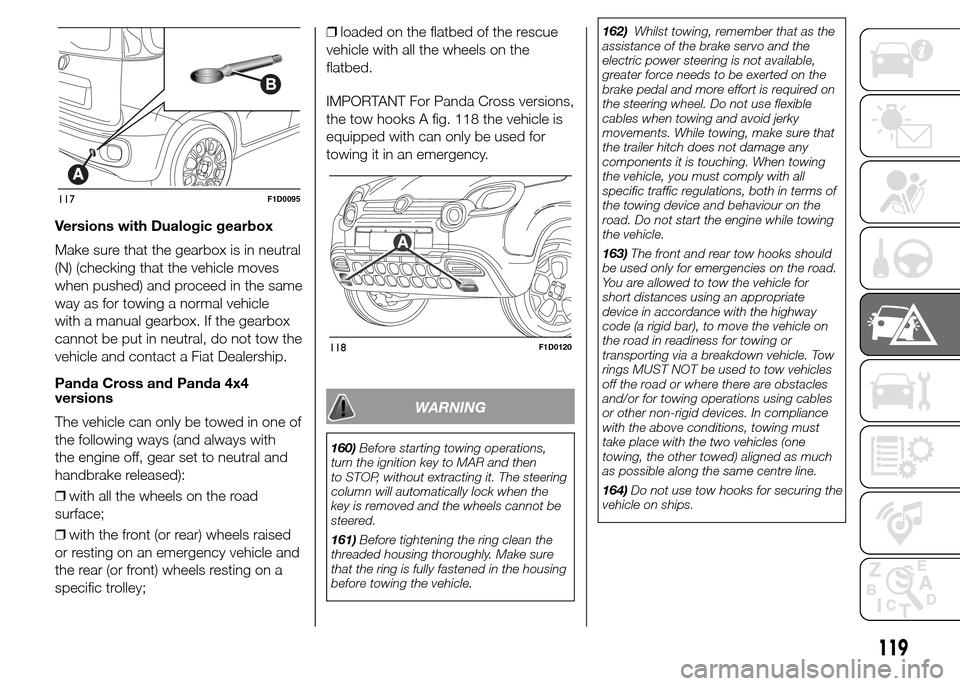
Versions with Dualogic gearbox
Make sure that the gearbox is in neutral
(N) (checking that the vehicle moves
when pushed) and proceed in the same
way as for towing a normal vehicle
with a manual gearbox. If the gearbox
cannot be put in neutral, do not tow the
vehicle and contact a Fiat Dealership.
Panda Cross and Panda 4x4
versions
The vehicle can only be towed in one of
the following ways (and always with
the engine off, gear set to neutral and
handbrake released):
❒with all the wheels on the road
surface;
❒with the front (or rear) wheels raised
or resting on an emergency vehicle and
the rear (or front) wheels resting on a
specific trolley;❒loaded on the flatbed of the rescue
vehicle with all the wheels on the
flatbed.
IMPORTANT For Panda Cross versions,
the tow hooks A fig. 118 the vehicle is
equipped with can only be used for
towing it in an emergency.
WARNING
160)Before starting towing operations,
turn the ignition key to MAR and then
to STOP, without extracting it. The steering
column will automatically lock when the
key is removed and the wheels cannot be
steered.
161)Before tightening the ring clean the
threaded housing thoroughly. Make sure
that the ring is fully fastened in the housing
before towing the vehicle.162)Whilst towing, remember that as the
assistance of the brake servo and the
electric power steering is not available,
greater force needs to be exerted on the
brake pedal and more effort is required on
the steering wheel. Do not use flexible
cables when towing and avoid jerky
movements. While towing, make sure that
the trailer hitch does not damage any
components it is touching. When towing
the vehicle, you must comply with all
specific traffic regulations, both in terms of
the towing device and behaviour on the
road. Do not start the engine while towing
the vehicle.
163)The front and rear tow hooks should
be used only for emergencies on the road.
You are allowed to tow the vehicle for
short distances using an appropriate
device in accordance with the highway
code (a rigid bar), to move the vehicle on
the road in readiness for towing or
transporting via a breakdown vehicle. Tow
rings MUST NOT be used to tow vehicles
off the road or where there are obstacles
and/or for towing operations using cables
or other non-rigid devices. In compliance
with the above conditions, towing must
take place with the two vehicles (one
towing, the other towed) aligned as much
as possible along the same centre line.
164)Do not use tow hooks for securing the
vehicle on ships.
117F1D0095
118F1D0120
119